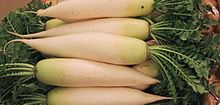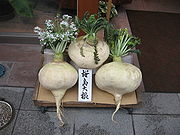- Daikon
-
Daikon 
A pile of daikon radishes. Scientific classification Kingdom: Plantae (unranked): Angiosperms (unranked): Eudicots (unranked): Rosids Order: Brassicales Family: Brassicaceae Genus: Raphanus Species: R. sativus Variety: R. sativus var. longipinnatus[1] Trinomial name Raphanus sativus var. longipinnatus
L.H.BaileyDaikon (from Japanese 大根, literally "large root"), Raphanus sativus var. longipinnatus, also called White Radish, Japanese radish, Oriental radish, Chinese radish, lo bok and Mooli (from Hindi/Urdu Muulii),[2][3][4] is a mild flavoured, very large, white East Asian radish. Despite being known most commonly by its Japanese name in the US, it did not originate in Japan, but rather in continental Asia. In the UK and continental Asia it is most commonly known as mooli.
Although there are many varieties of daikon, the most common in Japan, the aokubi-daikon, has the shape of a giant carrot, approximately 20 to 35 cm (8 to 14 in) long and 5 to 10 cm (2 to 4 in) in diameter. Another variety, the "Korean radish", is shorter, stouter, and has a pale green colour extending from the top, to approximately half way down the tuber. One of the most unusually shaped varieties of daikon cultivated in Kagoshima Prefecture is the turnip-shaped sakurajima daikon, which often grows as large as 50 cm (20 in) in diameter and weighs as much as 45 kg (100 lb).[5]
The flavour is generally rather mild compared to smaller radishes.
Contents
Culture
The variety 'Long White Icicle' is available as seed in Britain, and will grow very successfully in Southern England, producing roots resembling a parsnip by midsummer in good garden soil in an average year.[citation needed]
The Chinese radish or mooli tolerates higher temperatures than Japanese daikon, it grows well at lower elevations in East Africa. It is best if there is plenty of moisture and it can grow fast, otherwise it tastes too strong and its flesh is tough.[6]
Use
In Chinese cuisine, turnip cake and chai tow kway are made with daikon. The variety called mooli has a high water content, and should be salted and drained before it is cooked. Sometimes Mooli is used to carve elaborate garnishes.[7]
In Korean cuisine, a varietal is used to make kkakdugi and nabak kimchi use the vegetable, in addition to the soup muguk. This type of daikon is shorter, stouter, and has a pale green colour extending from the top, to approximately half way down the tuber.
In Japanese cuisine, many types of pickles are made with daikon including takuan and bettarazuke. Daikon is also frequently used shredded and mixed into ponzu (a soy sauce and citrus juice condiment) as a dip. Simmered dishes are also popular such as oden. Cut and dried daikon is called Kiriboshi-daikon(literally, cut-dried daikon) which is a common method of preserving food in Japan. Daikon radish sprouts (Kaiware-daikon) are used for salad or garnishing of sashimi. Daikon leaf is frequently eaten as green vegetables. Pickles and stir frying are common. The Daikon leaf is one of a leaves of Festival of Seven Herbs, called suzushiro.
In Pakistani and Bangladeshi cuisine, the young leaves of the daikon plant are boiled and flash fried with a mixture of heated oil, garlic, ginger, red chili and a variety of spices. The radish is eaten as a fresh salad often seasoned with either salt and pepper or Chaat masala.
In South India, daikon is the principal ingredient in a variety of sambhar, in which roundels of the radish are boiled with tamarind pulp, lentils and a special spice powder.[8] When cooked, it can release a very strong odor.
Storage
The roots can be stored for some weeks without the leaves if lifted and kept in a cool dry place. If left in the ground, the texture tends to become woody, but the storage life of untreated whole roots is not long.[clarification needed]
Nutritional information
Daikon is very low in food energy. A 100-gram serving contains only 90 kilojoules or 15 calories (6 Cal/oz), but provides 34 percent of the RDA for vitamin C. Daikon also contains the active enzyme myrosinase.
Notes
- ^ Mish, Frederick C., Editor in Chief. “Daikon.” Webster’s Ninth New Collegiate Dictionary. 9th ed. Springfield, MA: Merriam-Webster Inc., 1985. ISBN 0-87779-508-8, ISBN 0-87779-509-6 (indexed), and ISBN 0-87779-510-X (deluxe).
- ^ Davidson, Alan (2003). Seafood of South-East Asia: a comprehensive guide with recipes. Ten Speed Press. p. 211. ISBN 1580084524. http://books.google.com/books?id=8nhfSFs79fUC&pg=PA211&dq=Raphanus+sativus+var.+longipinnatus#v=onepage&q=Raphanus%20sativus%20var.%20longipinnatus&f=false.
- ^ Larkcom, Joy; Douglass, Elizabeth (1994). Oriental Vegetables: The Complete Guide for the Gardening Cook. Oxford University Press US. p. 111. ISBN 1568360177. http://books.google.com/books?id=-Dud21XvN30C&pg=PA111&dq=Raphanus+sativus+var.+longipinnatus#v=onepage&q=Raphanus%20sativus%20var.%20longipinnatus&f=false.
- ^ "Raphanus sativus L. (Longipinnatus Group)". MULTILINGUAL MULTISCRIPT PLANT NAME DATABASE. http://www.plantnames.unimelb.edu.au/new/Raphanus.html#longipinnatus.
- ^ The New official guide: Japan. Japan National Tourist Organization. 1975. p. 837. ISSN 0077-8591. http://books.google.com/books?cd=14&num=100&id=IU4lAAAAMAAJ&pg=PT287&dq=daikon&q=daikon.
- ^ Grubben, G.J.H.. Vegetables. PROTA. http://books.google.co.uk/books?id=6jrlyOPfr24C&lpg=PA444&dq=mooli%20africa%20growing&pg=PA444#v=onepage&q&f=false.
- ^ Doeser, Linda (2010). The Ultimate Chinese Cookbook. Hermes House. pp. 9. ISBN ISBN 1843093421.
- ^ http://www.sanjeevkapoor.com/mullangi-sambhar-foodfood.aspx
External links
Categories:- Brassicaceae
- Leaf vegetables
- Root vegetables
- Japanese cuisine terms
- Japanese ingredients
- Vietnamese ingredients
- Chinese ingredients
- Korean ingredients
Wikimedia Foundation. 2010.

